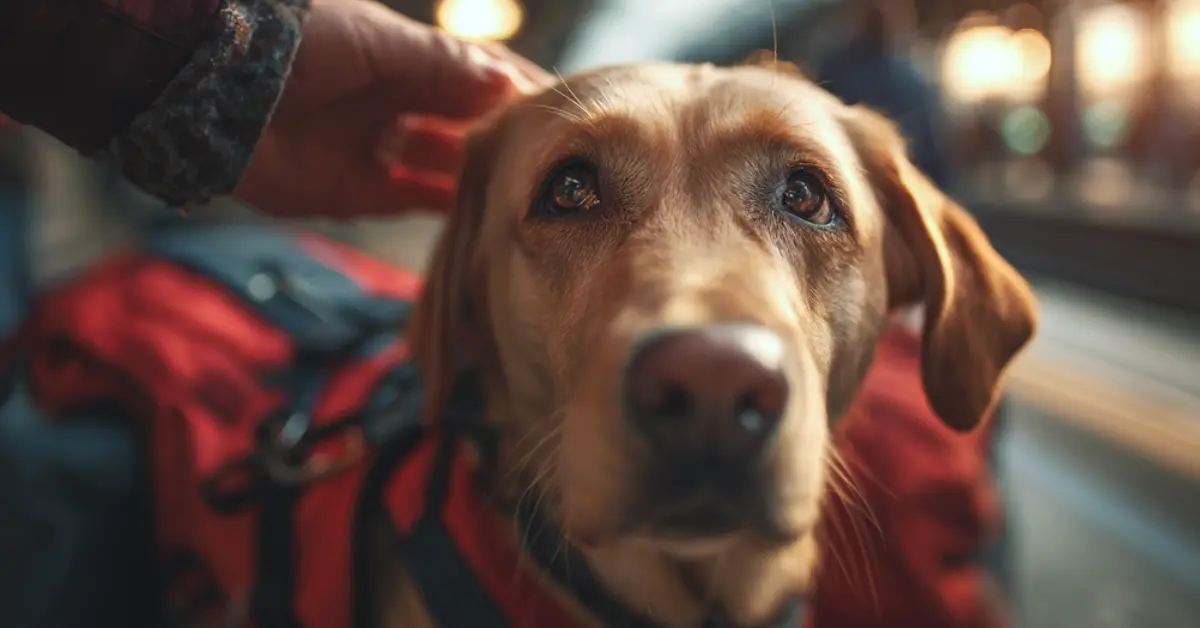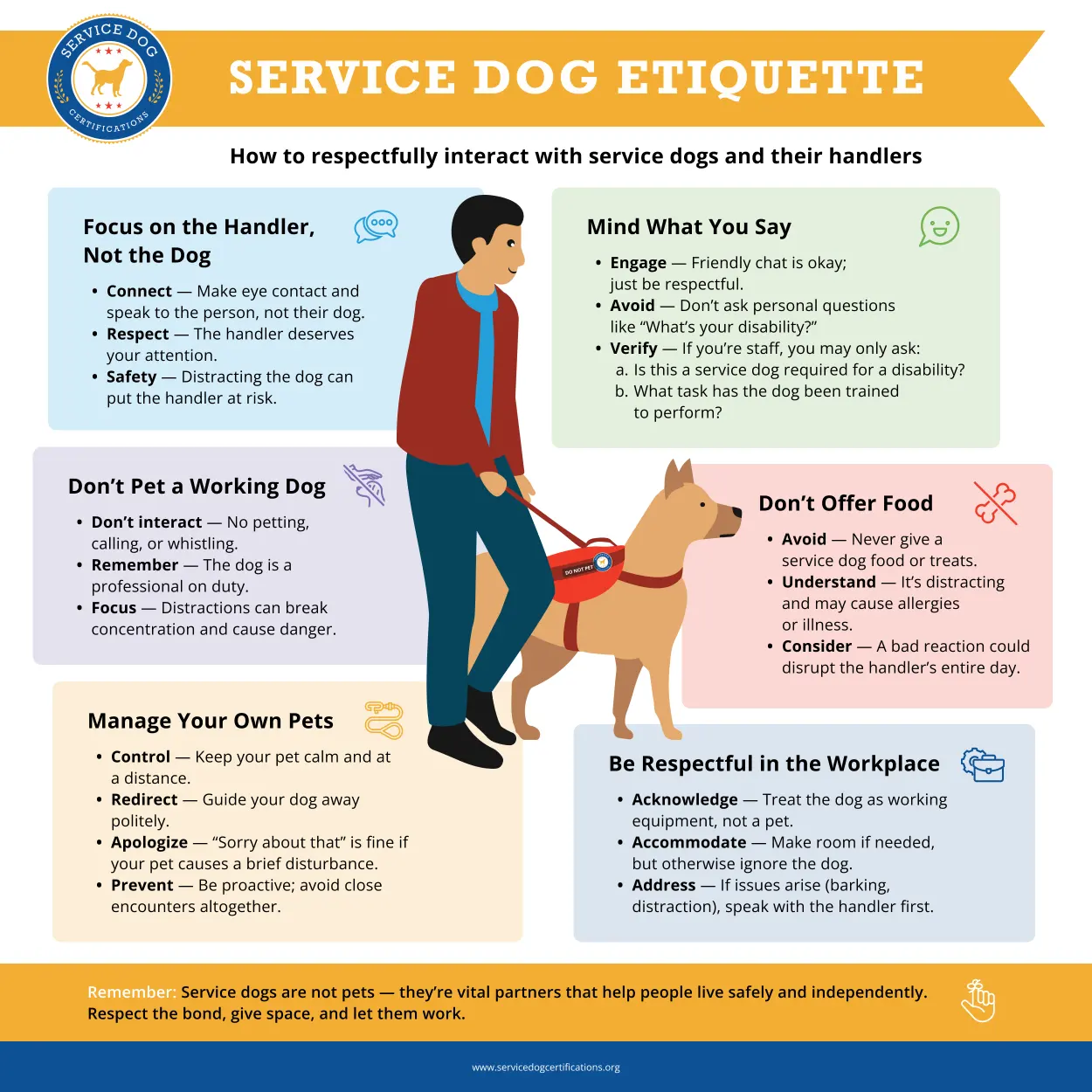Service Dog Etiquette

If you haven’t been around service dogs often, you may have questions about how to behave with the dogs and their handlers. In general, common sense is a good guide, but the following tips may be helpful:
In this article:
- Focus on the handler, not the dog
- Don’t pet service dogs
- Manage your own pets
- Don’t offer food
- Mind what you say
- Be respectful in the workplace
Share this image on your site
Focus on the Handler, Not the Dog
When you encounter a person with a service dog, it may seem natural to engage with the dog as you would with a pet. In this situation, however, it’s always best to connect with the handler, and not the dog. Why? Two big reasons:
- Respect. The handler is a human being, not a spokesperson for their service animal. If you wish to make a connection, make it first with the human who is handling the dog.
- Safety. When you engage with a dog, the dog engages with you. This is fine if the dog is simply trotting along, but it can become a safety issue when the dog stops working to attend to you. The dog may miss an important cue and endanger their handler.
Don’t Pet Service Dogs
Dog lovers love to pet dogs. But service dogs are working animals, which means they are essentially professionals. If you wouldn’t strike up a conversation with a medical professional as they perform their duties, you shouldn’t engage a service dog while it’s working. Not only is it potentially dangerous to the handler, it’s also disrespectful.
Manage Your Own Pets
You’re out walking your pet dog when he encounters a service dog. Your dog’s first instinct is to engage and play with the service animal, and it’s hard to keep him in check. What should you do?
If you’re already in the situation, the best option is to simply guide your pet in a different direction and put distance between yourself and the service dog. A simple apology may also be appropriate, as your pet has probably broken the service dog’s concentration.
To avoid the problem, it’s important to be proactive. For example, it’s smart to stay alert to the presence of service dogs in public places. If your pet is friendly, curious, or aggressive, avoid getting too close in the first place. Hang back, cross the street, or otherwise avoid engagement. At the same time, be careful not to block pathways or access that the handler and their dog might need.
Don’t Offer Food
You see a beautiful service dog working hard, and you happen to have some biscuits in your pocket for your own pup. Should you offer a biscuit to the service dog? The answer is no — not only because it’s distracting (and thus potentially dangerous) but also because service dogs may be on particular diets. If a service dog develops an allergic reaction or upset stomach, it can disrupt the owner’s entire day. What’s more, treating reactions to foods can be extremely costly.
Mind What You Say
It’s just fine to strike up a conversation with a service dog handler, but it’s important to be respectful. A good rule of thumb: don’t ask the handler any questions you yourself wouldn’t want to answer. For example, avoid questions like “What’s your disability?” If the dog handler wants to share that information (and it isn’t visually apparent), they will do so.
If you’re a store or restaurant owner or staff member, and want to verify service dog ownership, there are only two questions you can legally ask:
- Is the dog a service animal required because of a disability?
- What work or task has the dog been trained to perform?
In addition, of course, you can ask the same questions you’d ask anyone else. If you’re a shop employee, you might ask, “How can I help you?” If you’re meeting on the street, it’s best to make eye contact first, and then exchange ordinary pleasantries (“Nice weather we’re having!”). It is important, however, to avoid distracting the service dog in any way.
Be Respectful in the Workplace
When you encounter a service dog in a workplace or professional setting, the dog is present to support, guide, or protect its handler — and that’s all. The dog isn’t a pet, and it shouldn’t be a distraction. In fact, to the degree possible, it’s best to pretend that the dog isn’t there at all — unless you need to make room for the dog at a table or provide space for the handler and dog to move through your workspace.
In rare cases, a service dog and/or its handler may become a distraction. For example, a dog that barks unnecessarily or growls at co-workers is not acceptable. It can also become a health hazard in a sterile area.
If you encounter issues with a service dog, it’s best to bring up the issue with the handler first. If the handler can’t resolve the problem, it’s appropriate to bring it up with a supervisor.
Service dogs are trained to allow disabled individuals to travel, shop, work, and socialize safely and effectively. Unless their owners suggest otherwise, it’s best to treat service dogs as if they were an accessibility equipment. And just as you’d avoid asking direct questions about or touching an individual’s wheelchair, it’s best to avoid asking about or touching a service dog unless invited to do so.
About the Author: Lisa Jo Rudy, M.Div. has been writing on developmental disabilities and mental health since the early 2000s, when her son was diagnosed with autism. Lisa lives on Cape Cod, where she is the proud "mom" of two beautiful cats.
Related Articles

Hipster Dogs: Trendy Pups, Beards, and Beanies
From PBRs to beanie caps, and from plastic sunglasses to “pawsome” music, hipster dogs have taken the world by storm, and there’s no turning back. Because, let’s face it, these little guys and gals were rocking the style before it was cool — not that they would care what’s cool, though. For a “pawsitevly” good […]

Read More

How Dogs Can Calm Anxiety
A person suffering from anxiety attacks experience many risks, and it’s one of the reasons why it’s prudent to consider having a service dog or emotional support animal as a companion. The animal can keep the environment safer for the individual and below are some of the ways a dogs can calm anxiety: 1) Dogs […]

Read More

Can Cats Be Service Animals?
Having a cat brings the same positive effects as dogs. These pets can be equally beneficial to a person’s health. Experts have proven that cat owners are less likely to have a health emergency, such as a heart attack, with their feline companion around and cats have also been proven to help alleviate sleeping disorders, […]

Read More
